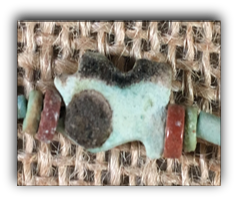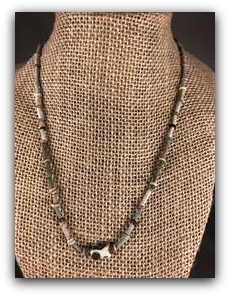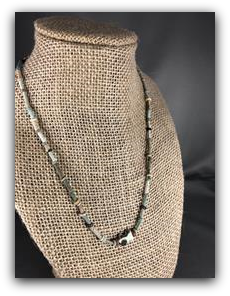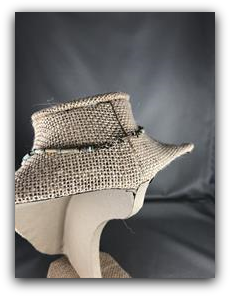
EGYPTIAN JEWELRY
ITEM#AB1036
Egyptian Faience Necklace, Late Period , CA 1085-343 BCE
Egyptian Faience Necklace, Late Period , CA 1085-343 BCE

AB1014 Late Dynastic Period, CA 1085-343 BCE. $135
These ancient Faience beads date from Egypt’s Late Dynastic Period, approximately the 21st to 30th Dynasties. They are a combination of tubular and disc beads in a variety of colors strung in a single strand that terminates with a small, crude Eye of Horus amulet, which signified healing properties. These beads have been strung for wearing, to a length of about 17 inches, plus the clasp, using modern materials and sterling clasp.
Guaranteed ancient as described.
These ancient Faience beads date from Egypt’s Late Dynastic Period, approximately the 21st to 30th Dynasties. They are a combination of tubular and disc beads in a variety of colors strung in a single strand that terminates with a small, crude Eye of Horus amulet, which signified healing properties. These beads have been strung for wearing, to a length of about 17 inches, plus the clasp, using modern materials and sterling clasp.
Guaranteed ancient as described.
Faience
Faience, a ceramic formed from a mixture of sand and quartz with additives for color, is considered to be the forerunner of true glass. It was used to produce beads for jewelry, as well as votive and utilitarian items. During firing, the added impurities migrated to the surface, creating the durable glaze and producing the beautiful colors it is so prized for. Large amounts of faience items were produced for funerary use as well, to accompany the departed into the afterlife. The greatest number of Egyptian beads were made of Faience, an inexpensive alternative to the precious stones they emulated, such as turquoise and lapis. Possibly invented in either Mesopotamia or Egypt, by 4000 BCE, Faience was the first mass produced synthetic material to simulate precious stones. The development of Faience, and eventually glass, satisfied the desire of the general populace to wear beads that emulated the precious stones of the wealthy.
Faience, a ceramic formed from a mixture of sand and quartz with additives for color, is considered to be the forerunner of true glass. It was used to produce beads for jewelry, as well as votive and utilitarian items. During firing, the added impurities migrated to the surface, creating the durable glaze and producing the beautiful colors it is so prized for. Large amounts of faience items were produced for funerary use as well, to accompany the departed into the afterlife. The greatest number of Egyptian beads were made of Faience, an inexpensive alternative to the precious stones they emulated, such as turquoise and lapis. Possibly invented in either Mesopotamia or Egypt, by 4000 BCE, Faience was the first mass produced synthetic material to simulate precious stones. The development of Faience, and eventually glass, satisfied the desire of the general populace to wear beads that emulated the precious stones of the wealthy.
Click any picture to enlarge











